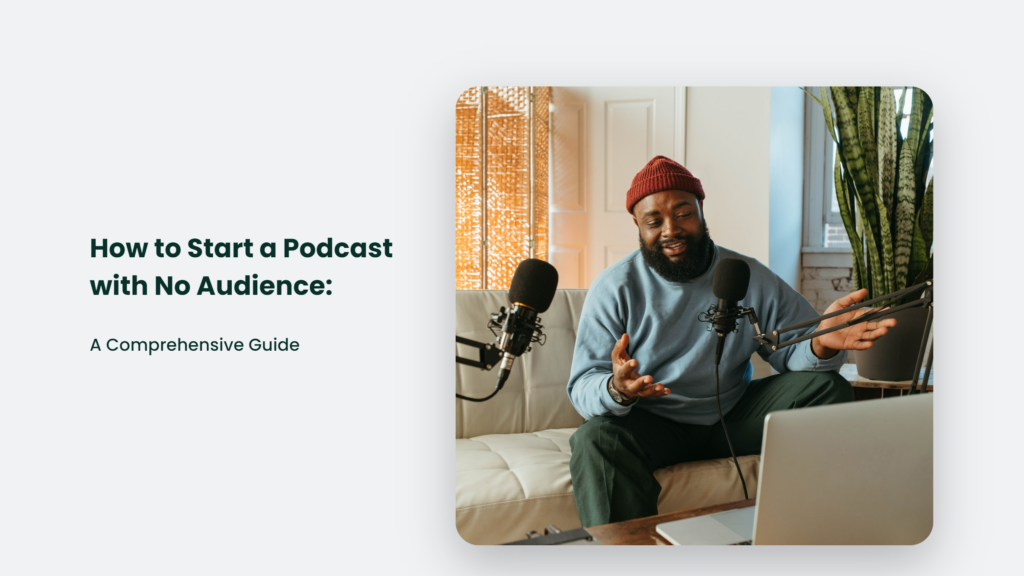Starting a podcast can seem daunting, especially when you don’t need an existing audience. However, with some strategic planning and persistence, organically growing a podcast audience from scratch is possible.
This comprehensive guide will walk you through the key steps for launching a successful podcast with no listeners. From choosing your niche to optimizing your content for discovery, you’ll learn proven tactics on how to start a podcast with no audience.

Why Start a Podcast With No Audience?
You may be wondering — why bother starting a podcast if you don’t already have listeners lined up? Here are some of the top reasons:
Establish Yourself as an Expert
Podcasting allows you to position yourself as a thought leader in your niche. You will gain authority and credibility with your target audience by consistently publishing high-quality content.
Low Barrier to Entry
Compared to other mediums like blogging or YouTube, podcasting has a relatively low barrier to entry. All you need to get started is a microphone, editing software, and a hosting platform.
Passive Income Potential
Once your podcast gains traction, there is huge potential to monetize it through sponsorships, affiliate marketing, or premium content. Top podcasters easily earn 6-7 figures per year.
Flexible Format
The podcast format lends itself well to on-the-go listening. As a result, you can rapidly grow a highly engaged audience as listeners tune in during commutes, workouts, etc.
Now that you know why starting a podcast is worthwhile even without an initial audience, let’s explore step-by-step how to launch a successful show.
How to Start a Podcast With No Audience:
Step 1: Identify Your Niche and Target Audience
The first step is identifying a specific niche and target audience to create content.
Aim to focus on a narrow niche that you’re truly passionate about. The narrower, the better. For example, instead of a general “health and fitness” podcast, you could niche down to “nutrition for female runners”.
Next, build a target listener profile, including demographics, interests, goals, and pain points. Get very detailed here. It will allow you to craft content specifically tailored to your ideal listener.
Step 2: Conduct Competitor Research
Once your niche and target audience are locked in, analyze any existing podcasts in your space. Learn what topics they cover, formats, length of episodes, etc.
This intel will help you differentiate and position yourself uniquely. It also prevents you from reinventing the wheel on content themes.
Step 3: Plan Initial Episodes and Format
Now it’s time to start mapping out your first few episodes. Outline the specific topics you’ll cover and each episode’s format.
In the early stages, focus on core topics that listeners find most useful. Think evergreen, foundational content.
Nail down the overall flow — will you do solo episodes? Interviews? A mix of both? Will there be recurring segments or special series? Getting clarity here is crucial.
Step 4: Set Up Your Podcast Production Studio
While you don’t need fancy equipment to record a podcast, you will need a few key essentials:
- Microphone: The Blue Yeti or Audio Technica AT2020 are great starter mics for under $150. Ensure the sound quality is crisp and clear.
- Editing software: Audacity is an accessible and user-friendly editing program for new podcasters.
- Hosting platform: Libsyn and Buzzsprout offer reliable hosting plans starting under $5/month.
Invest time recording and editing test episodes until you have high production quality. It optimizes listenability and minimizes drop-offs.
Step 5: Design Your Podcast Cover Art and Branding
Visually representing your podcast through cover art and branding is critical, especially for new shows.
Your branding should clearly convey your niche, the show’s vibe, and who it’s for.
Choose an eye-catching image that pops on both mobile and desktop for cover art. Use bold typography and visuals related to your niche.
Step 6: Launch Your Website
Launch a simple website for your podcast to establish credibility and have a hub to direct listeners to.
Ensure you include key information like episode descriptions, embeddable players, links to subscribe, etc. It makes it easy for new listeners to check you out.
Also, publish written content that complements each episode. It gives listeners value beyond the audio and surfaces your show in search engines.
Step 7: Submit Your Podcast to Directories
To maximize discoverability, submit your podcast feed to all major directories, including:
- iTunes
- Spotify
- Google Podcasts
- Stitcher
- Pandora
It distributes your show across platforms. Make it easy for new listeners stumbling upon related content to subscribe.
Step 8: Strategically Promote Your Show
When trying to grow an audience from nothing organically, promotion is everything. But avoid spammy tactics — focus on value-driven marketing:
Guest Appearances
Reaching out to aligned but more popular shows in your niche to be interviewed is hugely effective. Avoid directly pitching your podcast; instead, focus on providing value.
Influencer Partnerships
Partner with influencers like bloggers or YouTubers to co-create content or cross-promote episodes. Ensure it’s a win-win arrangement.
LinkedIn Publishing
Repurposing episodes into posts on LinkedIn taps into an actively engaged professional audience.
Facebook Groups
Join and actively participate in Facebook Groups related to your niche. Once you build authority, subtly weave in mentions of your show.
Step 9: Analyze Metrics and Listen to Feedback
Listen to listener feedback and review metrics to identify what content and formats resonate most.
Look at subscriber rates, downloads, reviews, emails, etc. Use this intel to shape future episodes and optimize accordingly.
Be willing to test new segment ideas, episode lengths, release schedules, etc, until you find the sweet spot.
Step 10: Rinse and Repeat
It’s just a matter of consistency once you nail your positioning and dial-in formats that genuinely help your audience.
Continue publishing high-quality content on a regular schedule. Persistently promote your show through various channels.
If you provide ongoing value tailored to your niche, your podcast will organically attract more loyal listeners.
Frequently Asked Questions:
How long does it take to build an audience for a new podcast?
It typically takes at least 6-12 months of consistent, high-quality content publishing to gain meaningful traction and listenership. Be patient and focus on the long game.
Should I wait until I have lots of episodes recorded before launching?
No! Get your first few episodes polished and published right away. You can then use them to start marketing your show and making connections. Just ensure you have a content calendar mapped out.
What metrics should I track for my podcast?
Key metrics to follow include downloads, subscribers, reviews, social media engagement and email list growth. Use Buzzsprout or other podcast host platforms to access this data.
In Closing
Launching a successful podcast from scratch is completely doable if you follow a strategic framework.
First, laser focus on a specific niche and target listener. Conduct competitor research to differentiate yourself. Plan out initial episodes and dial in your production.
Promote your show through guest appearances, influencer partnerships, social media and more. Analyze metrics to optimize content for your audience.
By relentlessly focusing on value and consistency, you can organically grow an engaged tribe without a pre-existing audience.
This guide gave you clarity on how to launch your podcast effectively. Now get out there, start recording, and make some waves!


![The ‘Giveaway Piggy Back Scam’ In Full Swing [2022]](https://www.cjco.com.au/wp-content/uploads/pexels-nataliya-vaitkevich-7172791-1-scaled-2-683x1024.jpg)

